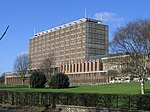County Ground, Lakenham
Cricket grounds in NorfolkDefunct cricket grounds in EnglandEnglish cricket ground stubsNorfolk building and structure stubsSports venues in Norwich

The County Ground in Lakenham, Norwich, Norfolk was a cricket ground for over two hundred years, hosting both first-class and List A cricket. Five first-class games, all involving touring international sides, were played here between 1912 and 1986, and 13 List A matches were staged between 1969 and 1998. The County Ground's most regular users, however, were Norfolk County Cricket Club, who played over 400 Minor Counties Championship games at the venue. In the early 21st century the ground was redeveloped for a variety of other uses.
Excerpt from the Wikipedia article County Ground, Lakenham (License: CC BY-SA 3.0, Authors, Images).County Ground, Lakenham
City Road, Norwich Lakenham
Geographical coordinates (GPS) Address Phone number Website Nearby Places Show on map
Geographical coordinates (GPS)
| Latitude | Longitude |
|---|---|
| N 52.616094444444 ° | E 1.3014638888889 ° |
Address
Lakenham Primary School
City Road
NR1 2HL Norwich, Lakenham
England, United Kingdom
Open on Google Maps









